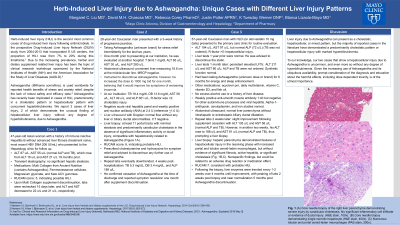Sunday Poster Session
Category: Liver
P1126 - Herb-Induced Liver Injury Due to Ashwagandha: Unique Cases With Different Liver Injury Patterns
Sunday, October 22, 2023
3:30 PM - 7:00 PM PT
Location: Exhibit Hall

Has Audio

Margaret C. Liu, MD
Mayo Clinic
Phoenix, AZ
Presenting Author(s)
Award: Presidential Poster Award
Margaret C. Liu, MD1, David M H. Chascsa, MD1, Rebecca Corey, PharmD1, Justin M. Potter, MSN, ACNP-BC2, K Tuesday Werner, ARNP1, Blanca Lizaola-Mayo, MD1
1Mayo Clinic, Phoenix, AZ; 2Mayo Clinic, Peoria, AZ
Introduction: Herbal and dietary supplements, such as Ashwagandha (Withania somnifera), are used worldwide for reported health benefits of stress and anxiety relief, despite the lack of robust safety and efficacy data. Ashwagandha has recently been implicated in cases of herb-induced liver injury, predominantly in a cholestatic pattern or hepatocellular pattern with concurrent hyperbilirubinemia. We report 3 cases of liver injury, 2 of which demonstrate the unusual finding of hepatocellular liver injury without any degree of hyperbilirubinemia, due to Ashwagandha.
Case Description/Methods: Our first case is a 28-year-old man who presented with cholestatic liver injury after increasing his Ashwagandha dosage. Biopsy demonstrated canalicular cholestasis (Fig. 1A). Liver enzymes markedly improved 1 month post supplement discontinuation. Our second case is a 57-year-old man who presented with elevated aminotransferases in the setting of Ashwagandha use, with laboratory values consistent with hepatocellular injury. Biopsy demonstrated features of hepatocellular injury in the resolving phase with increased portal and lobular ceroid-laden macrophages (Fig. 1B,C). Liver enzymes normalized 5 months post supplement discontinuation. Our third case is a 47-year-old woman with a history of immune inactive Hepatitis B without advanced liver fibrosis who presented with new onset mild hepatocellular liver injury without any hyperbilirubinemia in the setting of Ashwagandha use. No biopsy was done, as liver enzymes normalized 2 weeks after supplement discontinuation.
Discussion: Liver injury due to Ashwagandha can present as a cholestatic, hepatocellular, or mixed pattern, but the majority of reported cases in the literature have demonstrated a predominantly cholestatic pattern or hepatocellular injury with marked hyperbilirubinemia. To our knowledge, our 2 cases that show a hepatocellular injury due to Ashwagandha use is uncommon, and even more so without any degree of hyperbilirubinemia. Given the increasing use of Ashwagandha and its ubiquitous availability, prompt consideration of the diagnosis and education about the harmful effects, including dose dependent toxicity, is of the utmost importance.

Disclosures:
Margaret C. Liu, MD1, David M H. Chascsa, MD1, Rebecca Corey, PharmD1, Justin M. Potter, MSN, ACNP-BC2, K Tuesday Werner, ARNP1, Blanca Lizaola-Mayo, MD1. P1126 - Herb-Induced Liver Injury Due to Ashwagandha: Unique Cases With Different Liver Injury Patterns, ACG 2023 Annual Scientific Meeting Abstracts. Vancouver, BC, Canada: American College of Gastroenterology.
Margaret C. Liu, MD1, David M H. Chascsa, MD1, Rebecca Corey, PharmD1, Justin M. Potter, MSN, ACNP-BC2, K Tuesday Werner, ARNP1, Blanca Lizaola-Mayo, MD1
1Mayo Clinic, Phoenix, AZ; 2Mayo Clinic, Peoria, AZ
Introduction: Herbal and dietary supplements, such as Ashwagandha (Withania somnifera), are used worldwide for reported health benefits of stress and anxiety relief, despite the lack of robust safety and efficacy data. Ashwagandha has recently been implicated in cases of herb-induced liver injury, predominantly in a cholestatic pattern or hepatocellular pattern with concurrent hyperbilirubinemia. We report 3 cases of liver injury, 2 of which demonstrate the unusual finding of hepatocellular liver injury without any degree of hyperbilirubinemia, due to Ashwagandha.
Case Description/Methods: Our first case is a 28-year-old man who presented with cholestatic liver injury after increasing his Ashwagandha dosage. Biopsy demonstrated canalicular cholestasis (Fig. 1A). Liver enzymes markedly improved 1 month post supplement discontinuation. Our second case is a 57-year-old man who presented with elevated aminotransferases in the setting of Ashwagandha use, with laboratory values consistent with hepatocellular injury. Biopsy demonstrated features of hepatocellular injury in the resolving phase with increased portal and lobular ceroid-laden macrophages (Fig. 1B,C). Liver enzymes normalized 5 months post supplement discontinuation. Our third case is a 47-year-old woman with a history of immune inactive Hepatitis B without advanced liver fibrosis who presented with new onset mild hepatocellular liver injury without any hyperbilirubinemia in the setting of Ashwagandha use. No biopsy was done, as liver enzymes normalized 2 weeks after supplement discontinuation.
Discussion: Liver injury due to Ashwagandha can present as a cholestatic, hepatocellular, or mixed pattern, but the majority of reported cases in the literature have demonstrated a predominantly cholestatic pattern or hepatocellular injury with marked hyperbilirubinemia. To our knowledge, our 2 cases that show a hepatocellular injury due to Ashwagandha use is uncommon, and even more so without any degree of hyperbilirubinemia. Given the increasing use of Ashwagandha and its ubiquitous availability, prompt consideration of the diagnosis and education about the harmful effects, including dose dependent toxicity, is of the utmost importance.

Figure: Fig. 1: (A) Core needle biopsy of the right liver parenchyma demonstrating severe injury by canalicular cholestasis. No significant inflammatory cell infiltrate or evidence of ductal injury. (H&E stain at 100x). (B) Core needle biopsy demonstrating single necrotic hepatocyte (H&E stain at 400x). (C) Numerous lobular and portal ceroid-laden macrophages (PAS stain at 200x).
Disclosures:
Margaret Liu indicated no relevant financial relationships.
David Chascsa indicated no relevant financial relationships.
Rebecca Corey indicated no relevant financial relationships.
Justin Potter indicated no relevant financial relationships.
K Tuesday Werner indicated no relevant financial relationships.
Blanca Lizaola-Mayo indicated no relevant financial relationships.
Margaret C. Liu, MD1, David M H. Chascsa, MD1, Rebecca Corey, PharmD1, Justin M. Potter, MSN, ACNP-BC2, K Tuesday Werner, ARNP1, Blanca Lizaola-Mayo, MD1. P1126 - Herb-Induced Liver Injury Due to Ashwagandha: Unique Cases With Different Liver Injury Patterns, ACG 2023 Annual Scientific Meeting Abstracts. Vancouver, BC, Canada: American College of Gastroenterology.

